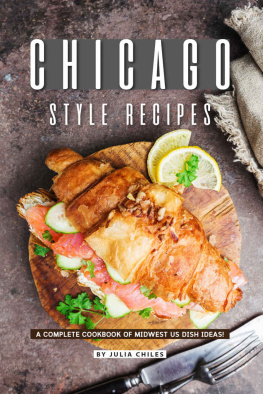

Published by American Palate
A Division of The History Press
Charleston, SC
www.historypress.net
Copyright 2016 by Amy Bizzarri
All rights reserved
First published 2016
e-book edition 2016
ISBN 978.1.62585.810.8
Library of Congress Control Number: 2016948310
print edition ISBN 978.1.46713.551.1
Notice: The information in this book is true and complete to the best of our knowledge. It is offered without guarantee on the part of the author or The History Press. The author and The History Press disclaim all liability in connection with the use of this book.
All rights reserved. No part of this book may be reproduced or transmitted in any form whatsoever without prior written permission from the publisher except in the case of brief quotations embodied in critical articles and reviews.
CONTENTS
INTRODUCTION
Chicago is a city of big shoulders and big appetites. Our citys iconic dishes, desserts and drinks reflect our history as the hog butcher of the world, stacker of wheat and player with railroads and the nations freight handler. Scraps of meat were transformed into dishes altogether sublime, breads and cakes sustained and sweetened lives, rail cars shipped meat to the East Coast and came back packed with the fruits of the ocean. Our rich immigrant history altered and expanded our taste buds.
Former mayor Richard J. Daley described Chicago as the city that works, and the food that fuels a Chicago workday needs to be hearty and filling, portable, inexpensive and belly warming enough to sustain us through our cold winter days. The recipes featured herein recall our citys hard-at-work history, as well as the restaurants, bakeries, taverns and humble pushcarts that were loved by our great-grandparents, grandparents and parents. If were lucky, theyll be cherished by our children, too. These are the iconic dishes, desserts and drinks that shaped the food landscape in Chicago, defining not just food history but also the history of the people who call this windy, wonderful city home.
BERTHA PALMERS BROWNIES
If Chicago had royalty, Bertha Palmer would be considered one of the most generous queens in city history. Intelligent, inventive and beautiful, she bestowed her charm and grace on a gritty city on the move. Born in 1849 in Louisville, Kentucky, with a silver spoon in her mouth, she was so striking that Chicago retail and real estate magnate Potter Palmer, rendered instantly dumbstruck the first time he met her, waited until she came of age, in 1870, to marry her. Historian Ernest Poole described her best when he said, She was beautiful, dashing, quick, and smart; and more than that, she was sure of herself.
But Bertha Palmer was not a mere socialite, content with living the gilded life in a rapidly growing Chicago. When Potter Palmers Palmer House Hotela wedding gift to Berthaburned to the ground in the Great Chicago Fire of 1871, she supported her husband as he rebuilt his fortune from the ashes. She played a key role in the citys social and cultural development and was an early member of the politically active Chicago Womans Club. Bertha Palmer voiced her support of universal kindergarten as an integral part of the Chicago school system. She campaigned for basic womens rights, including subsidized milk for impoverished children and better care for the children of imprisoned mothers. As president of the board of lady managers for the Worlds Columbian Exposition, she worked to ensure that women were well represented in both the Womens Building and beyond; her first step was her insistence that a competitionopen to women onlybe held to select the architect of the Womans Building. She was a savvy patron of the arts, collecting a number of French impressionist works, now the central masterpieces of the Art Institute of Chicagos collection. At the Worlds Columbian Exposition of 1893 dedication ceremony, Bertha remarked, Even more important than the discovery of Columbus, which we are gathered together to celebrate, is the fact that the general government has just discovered women.

Youll find Bertha Palmers original brownie at the historic Palmer House Hilton, Chicago. Image courtesy of the Palmer House Hilton, Chicago.
Many people dont know that this grand dame invented one of Americas tastiest treats: the brownie. During the 1893 exposition, Bertha Palmer worked with the Palmer House pastry chef to create a delicious dessert that would be compact enough to fit into a boxed lunch for attending ladies. Smart, stylish ladies need not worry about crumbs landing in their laps. The result was the rich, chocolaty, yet petite and less crumbly brownie, a small square that was big on taste yet offered a more elegant eating experience for ladies on the move.
The Palmer House still sticks to the original, rich and chocolaty brownie recipe, which calls for more than a pound of melted, top-quality chocolate; a pound of melted butter; and an apricot jelly glaze. The best place to enjoy Berthas brownie is in the ever-sublime Lobby Bar in the Palmer House Hilton, which remains one of the most historic and stunning hotel lobbies in the world.
Bertha Palmers Brownies
14 ounces semi-sweet chocolate
1 pound butter
12 ounces granulated sugar
4 ounces flour
8 eggs
Vanilla extract
12 ounces crushed walnuts
Preheat oven to 300 Fahrenheit. Melt chocolate and butter in a double boiler. Mix sugar and flour together in a bowl. Combine chocolate and flour mixtures. Stir 4 to 5 minutes. Add eggs and vanilla extract and continue mixing.
Pour mixture into a 9 x 12 baking sheet. Sprinkle walnuts on top, pressing down slightly into the mixture with your hand. Bake for 30 to 40 minutes. Brownies are done when the edges begin to crisp and have risen about of an inch.
Note: when brownie is properly baked, it will remain gooey with a toothpick in the middle due to the richness of the mixture.
Glaze
1 cup water
1 cup apricot preserves
1 teaspoon unflavored gelatin
Mix together water, preserves and unflavored gelatin in a saucepan. Mix thoroughly and bring to a boil for 2 minutes. Brush hot glaze on brownies while still warm.
Recipe courtesy of the Palmer House Hilton Hotel, Chicago
CHICAGO-STYLE GIARDINIERA
Giardiniera is Chicagos most celebrated condiment. Tangy, spicy and sweet, it cuts the richness of its best friend, the Italian beef sandwich, adding an extra element of crunch. Though it should be pronounced Jar-Din-Air-Ah, true Chicagoans cut off that last Ah syllable.
While sottoaceti, pickled and canned veggies, are common in Italy, Chicago was the first to concoct a sottoaceti recipe of its very own. Here in Chicago, we up the ante, adding more chilies and skipping a few of the ingredients found in a traditional Italian sottoaceti, shares Chicago-based foodie John Amici.
The result is more condiment than antipasto, and its a staple of most reputable sandwich shops. In fact, in some circles, its almost sacrilege to order an Italian beef sandwich without a healthy scoop of giardiniera to top it off. Good giardiniera also makes a great topping for any sandwich, as well as for burgers, hot dogs and brats, while a healthy sprinkling of it can elevate even the most lackluster of pizzas.
Next page








